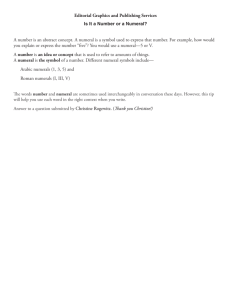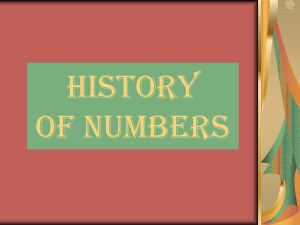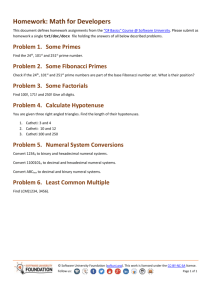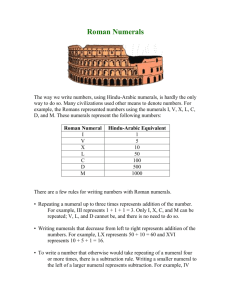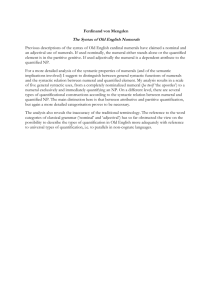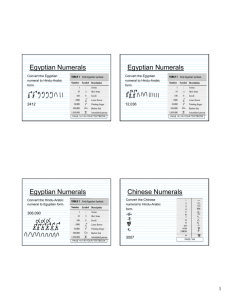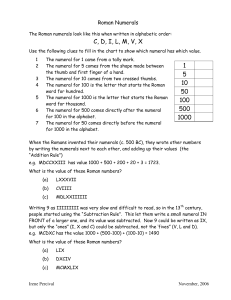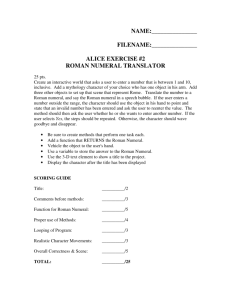The Development of Hindu-Arabic and Traditional Chinese Arithmetic
advertisement
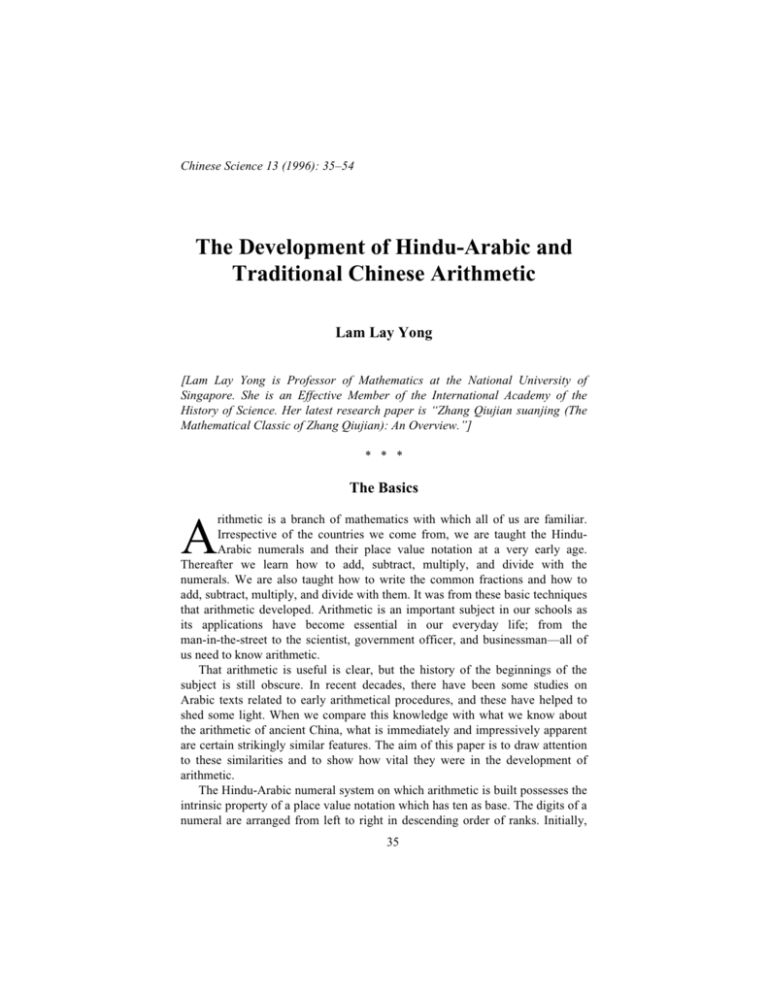
Chinese Science 13 (1996): 35–54 The Development of Hindu-Arabic and Traditional Chinese Arithmetic Lam Lay Yong [Lam Lay Yong is Professor of Mathematics at the National University of Singapore. She is an Effective Member of the International Academy of the History of Science. Her latest research paper is “Zhang Qiujian suanjing (The Mathematical Classic of Zhang Qiujian): An Overview.”] * * * The Basics rithmetic is a branch of mathematics with which all of us are familiar. Irrespective of the countries we come from, we are taught the HinduArabic numerals and their place value notation at a very early age. Thereafter we learn how to add, subtract, multiply, and divide with the numerals. We are also taught how to write the common fractions and how to add, subtract, multiply, and divide with them. It was from these basic techniques that arithmetic developed. Arithmetic is an important subject in our schools as its applications have become essential in our everyday life; from the man-in-the-street to the scientist, government officer, and businessman—all of us need to know arithmetic. That arithmetic is useful is clear, but the history of the beginnings of the subject is still obscure. In recent decades, there have been some studies on Arabic texts related to early arithmetical procedures, and these have helped to shed some light. When we compare this knowledge with what we know about the arithmetic of ancient China, what is immediately and impressively apparent are certain strikingly similar features. The aim of this paper is to draw attention to these similarities and to show how vital they were in the development of arithmetic. The Hindu-Arabic numeral system on which arithmetic is built possesses the intrinsic property of a place value notation which has ten as base. The digits of a numeral are arranged from left to right in descending order of ranks. Initially, A 35 36 Chinese Science 13 (1996) the system employed only nine signs which represented the numbers from one to nine. For example, the number sixty-five thousand three hundred and ninetytwo was written in the form 65392 so that the signs representing six, five, three, nine, and two were written in a horizontal line from left to right. The place occupied by each digit indicated the rank of that digit; in this example, the ranks of the digits 6, 5, 3, 9, and 2 were ten thousands, thousands, hundreds, tens, and units, respectively. A number such as sixty-five thousand three hundred and two was indicated by the appropriate signs for 6, 5, 3, and 2 which occupied their due places, while the place which represented the tens rank was left vacant. This blank space was called sunya in India and sifr in the Arab world, both words meaning empty.1 A tenth sign, which was usually in the form of the zero symbol (occasionally it was a dot), was introduced later to occupy this vacant place. The rules for manipulating the Hindu-Arabic numerals and the processes of calculation were known in the West through Latin translations of Arabic manuscripts from the twelfth century. The procedure of computation was called “algorism.” This word is generally accepted as associated with the name of Muhammad ibn MÞsâ al-Khwârizmî of the ninth century. The Latin text of Cambridge University Library Ms. Ii.vi.5, dating from the thirteenth century, is generally accepted as a copy of an earlier Latin translation of an Arabic manuscript based on the arithmetic text by al-Khwârizmî. The incomplete manuscript has only sixteen pages2 of which the first four and a half pages are devoted to a description of the Hindu-Arabic numerals with detailed explanations of the place value notation. Except for the last part on fractions and two short paragraphs on halving and doubling and casting out nines, the rest of the manuscript is concerned with the operations of addition, subtraction, multiplication, and division. An English translation of the part describing the division of 46468 by 324 is reproduced below so as to give the reader some idea of how the process of division was described and performed.3 And know that division is similar to multiplication, but this is done inversely, because in division we subtract and there we add, i.e., in multiplication is its 1 Karl Menninger, Number Words and Number Symbols: A Cultural History of Numbers, translated by Paul Broneer from the revised 1958 German edition (Cambridge, Mass.: MIT Press, 1969), pp. 400–401; Tobias Dantzig, Number: The Language of Science (London: George Allen & Unwin, 1930, 3rd ed. 1947), pp. 29–30; Louis C. Karpinski, The History of Arithmetic (Chicago: Rand McNally, 1925), p. 41. 2 The manuscript occupies folios 104r-111v, which were previously numbered as 102– 109 in A Catalogue of the Manuscripts Preserved in the Library of the University of Cambridge, vol. 3 (Cambridge: Cambridge Univ. Press, 1858), pp. 500–501. 3 John N. Crossley and Alan S. Henry, “Thus Spake Al-Khwârizmî: A Translation of the Text of Cambridge University Library Ms. Ii.vi.5,” Historia Mathematica vol. 17, no. 2 (May 1990), pp. 118–19. Lam Lay Yong: Hindu-Arabic and Traditional Chinese Arithmetic model. But when we wanted to divide forty-six thousand and four hundred and sixty-eight by three hundred and XXIIII, we first put eight on the right side, then we put six toward the left which is sixty, then IIII which is four hundred, then six which is VI thousand, then IIII which is forty-thousand. Of these places the last toward the left will be IIII, and the first of them toward the right eight; after this write under them the number by which you are dividing, and write the last place of the number by which you are dividing, which is the form of three and is three hundred, under the last place of the upper number which is IIII, provided that it is less than that which is above it: and if it were more than it, we shall move it by one place and put it under the six. After this we shall put in that place, that comes after the three, the form of two which is XX, beneath the six; then we shall put in that place, which is beneath the IIII, likewise IIII and this will be their form: 46468 324 After this to begin with let us write one in the column of the first place of the number by which you are dividing, above the upper number that you are dividing which is four. And if we had put it beneath the IIII, it would be equally appropriate. Let us multiply it (i.e., one) by three, and we shall subtract it (i.e., 3) from that which is above it, and there will remain one. Then let us multiply it by two and subtract it (i.e., 2) from that which is above it, which is VI, and there will remain IIII. After this let us multiply it again by IIII and subtract it (i.e., 4) from that which is above it, which is IIII and nothing will remain; and we shall put a circle in its place. Next move the beginning of the number by which you are dividing, i.e., IIII, beneath VI and there will be two beneath the circle and III beneath IIII. Then write in the column of the lower number something in the column [sic, should be “row”] of the one, i.e., IIII, and multiply it by three and there will be XII; and subtract it (i.e., 12) from that which is above three which is XIIII and there will remain II; after this multiply also IIII itself by the two that follows the three and there will be VIII, and subtract it (i.e., 8) from that which is above it, that is XX and there will remain XII, i.e., two above the II and one above the three. Again multiply IIII by IIII which comes next on the right, and there will be XVI; and subtract it (i.e., 16) from that which is above it which is CXXVI and there will remain above the IIII a circle and above the two, one, and above the three, one. Again move the number by which you are dividing, i.e., IIII, beneath VIII, and there will be two beneath the circle and three beneath the one; next write three in the column of IIII above the upper number that you are dividing in the row of IIII and one (i.e., 143), multiply it (i.e., 3) by three, and there will be IX; and subtract it (i.e., 9) from that which is above three which is XI and there will remain two above the three. Multiply also the three by the two that follows the three and there will be VI, and subtract it (i.e., 6) from that which is above the three, which is XX; there will remain XIIII. Once more multiply the aforesaid three by IIII that follows the two and there will be XII, and 37 38 Chinese Science 13 (1996) subtract it from that which is above it, which is CXXVIII . . . ;4 and there will remain six above the IIII, and three above the two, and one above the three. And there will come out for us what is owed to one from it and this will be CXLIII and CXXXVI parts from CCCXXIIII parts of one (i.e., 143 136 324 ). And this is their form: 143 136 324 Vogel5 points out that this lengthy description was equivalent to the following steps or “algorism”: 1 1 46468 14068 324 324 14 14068 324 14 2068 324 14 1268 324 14 1108 324 143 1108 324 143 208 324 143 148 324 143 136 324 The section on division in the manuscript begins with a general description of the process of division which is illustrated by the above example and followed by the division of 1800 by 9. Only one method of division is employed. In the same vein, only one type of addition method, one type of subtraction method, and one type of multiplication method are described in the manuscript.6 There are examples to illustrate the multiplication and subtraction methods, but there is only a general description for the addition method. Vogel’s summary of the steps for the subtraction of 3211 from 6422 and the multiplication of 2326 by 214 are shown below:7 6422 3211 4 3422 211 3222 11 3212 1 3211 It has been pointed out in Crossley and Henry, “Thus Spake Al-Khwârizmî,” p. 119, that the text has “CXXVIII” instead of the correct number “CXLVIII.” 5 Kurt Vogel, Mohammed ibn MÞsâ Alchwarizi's Algorismus (Aalen: Otto Zeller Verlagsbuchhandlung, 1963), p. 47. 6 For an English translation, see Crossley and Henry, “Thus Spake Al-Khwârizmî,” pp. 110–17. 7 Vogel, Mohammed ibn MÞsâ, pp. 45–46. Lam Lay Yong: Hindu-Arabic and Traditional Chinese Arithmetic 2326 214 428326 214 428326 214 492226 214 496486 214 39 497764 Each procedure begins from left to right and accuracy in the computation depends on the correct positioning of the digits of one numeral relative to those of the other. In the case of multiplication, note that the multiplier, 214, like the divisor in the above example, is shifted place by place from left to right. Its first position is such that its units digit, 4, is directly below the first digit from the left of the numeral to be multiplied. This first digit of the upper numeral is multiplied by each digit of the lower numeral commencing from the left. It is erased when the product is written in its place.8 The multiplier is then shifted to the right by one place so that its units digit, 4, is directly below 3. The first digit from the left of the lower numeral, 2, multiplies 3 and the product is added to the digit directly above 2, so that the upper numeral is changed to 488326. Next, 1 multiplies 3 and the product is added to the digit directly above 1, so that the upper numeral is changed to 491326. Finally, 4 multiplies 3, 3 is erased and the upper numeral is changed to 492226. The multiplier is shifted to the right by one place so that 4 is now directly below 2. The process continues till all the digits of the upper numeral are multiplied; the multiplier is then erased leaving the result. The Kitâb al-FusÞl fî al-Hisâb al-Hindî, written in Damascus in AD 952–953 by AbÞ al-Hasan Ahmad ibn Ibrâhîm al-Uqlîdisî, is, according to Saidan, the earliest extant Arabic work of Hindu-Arabic arithmetic and shows “this system at its earliest stages and the first steps in its development.”9 The manuscript claimed to have a collection of all past knowledge on arithmetic, a clear exposition of what was currently known about the subject, adaptations of and improvements on methods using paper as a medium, and other new contributions.10 The book therefore has several methods of addition, subtraction, multiplication, and division; what is significant is that the first method of each operation11 is the same as that described in the Cambridge manuscript.12 8 The product is in bold print. 9 A. S. Saidan, The Arithmetic of Al-Uqlîdisî (Dordrecht: D. Reidel, 1978), p. xi. 10 Saidan, The Arithmetic of Al-Uqlîdisî, pp. 35–36. Saidan, The Arithmetic of Al-Uqlîdisî, pp. 46–59. 12 The translated passage from Saidan, The Arithmetic of Al-Uqlîdisî, p. 49 shows how al-Uqlîdisî began his description of the procedure for multiplication: 11 We start with the multiplication of whole numbers. Multiplication of rubies is to be started with; that is multiplication of numbers from one to ten, equal or unequal. These must be memorized and learnt. Then comes multiplication of two places 40 Chinese Science 13 (1996) It was quite common for authors in Islam writing on the four fundamental operations of arithmetic to begin with a detailed description of these original methods.13 In his Kitâb fî UsÞl Hisâb al-Hind (Principles of Hindu reckoning), KÞshyâr ibn Labbân (fl. ca. 971–ca. 1029), after introducing the numerals, launches into a detailed description of the same procedures for addition, subtraction, multiplication, and division.14 In the second part of his book, he gives a different set of methods based on sexagesimal numbers. In his book, al-Uqlîdisî pointed out that this first set of methods for performing the four fundamental operations of arithmetic was done on a dustboard called the takht.15 Levey and Petruck also mention the use of the same device for KÞshyâr ibn Labbân’s arithmetic. The dustboard was a writing surface on which the reckoner spread dust.16 This enabled him to write numbers with a stylus or with the tip of his finger; manipulation depended on rubbing out digits.17 This first set of methods of how to add, subtract, multiply, and divide with Hindu-Arabic numerals is of historic importance because it is not only the earliest known in Islam, it is also the earliest known in the history of arithmetical procedures performed through the Hindu-Arabic numeral system. The detailed records of the Arabic arithmeticians reveal that the concept of the numeral system and its accompanying methods of operations were learned stepby-step as a package. From this foundation, they adapted, modified, and improved the procedures for a paper and ink medium.18 The ancient Chinese performed their addition, subtraction, multiplication, and division using rods made from animal bones or bamboo. Rods were used for reckoning since the Warring States period (475–221 BC) and possibly earlier, and through their use a numeral system was developed. The numeral system possessed the same intrinsic property as the Hindu-Arabic numeral system: it by one, like multiplying 74 by 9. We draw up the nine under the seven, like this: 74 . 9 Now we multiply 9 by 7 and insert the units of the result in place of seven, and the tens after it, thus having 6 3 4 . 9 Then the nine is shifted and set under the four. It is multiplied by four; the units are inserted in place of four, and the tens are added to the next place. The result is 6 6 6 which is the result of multiplication. 9 13 Saidan, The Arithmetic of Al-Uqlîdisî, p. 13. 14 Martin Levey and Marvin Petruck, KÞshyâr ibn Labbân: Principles of Hindu Reckoning (Madison: Univ. of Wisconsin Press, 1965), pp. 48–60. 15 Saidan, The Arithmetic of Al-Uqlîdisî, p. 35. 16 Levey and Petruck, KÞshyâr ibn Labbân, pp. 4–5, 41. 17 Saidan, The Arithmetic of Al-Uqlîdisî, p. 13. 18 Saidan, The Arithmetic of Al-Uqlîdisî, p. 14. Lam Lay Yong: Hindu-Arabic and Traditional Chinese Arithmetic 41 used a place value notation with ten as base. The nine signs which represented the numbers from one to nine were as follows: A rod numeral representing a number such as sixty-five thousand three hundred and ninety-two would appear as . The rods representing the digits five and nine which occupied places whose ranks were thousands and tens respectively were rotated through ninety degrees so that a horizontal rod was turned into a vertical one and a vertical rod was turned into a horizontal one. The numeral system had a place value notation with ten as base through this ingenious device of rotating the rods of the digits which occupied alternate places. The rotated nine signs which occupied places whose ranks were tens, thousands, hundred thousands, and so forth, were as follows: A numeral representing a number such as sixty-five thousand three hundred and two would appear as : the place that represented the tens rank was left blank and was called kong (empty). (The mathematiAmong the extant literature, the Sun Zi suanjing cal classic of Sun Zi) (ca. 400 AD) has the earliest description of how multiplication and division were performed with the rod numerals. Comparing this description of the detailed procedures with those described in the Arabic texts of the earliest known method of multiplication and division leads to a startling discovery: the step-by-step procedures are the same in spite of the different media and the vast difference in the dates of the records. The Sun Zi suanjing gives a general description of the rod numerals and how to multiply and divide with them. It also provides specific problems to illustrate the multiplication and division process.19 A translation of a problem on multiplication is reproduced here. Models of rod numerals20 are constructed to show the different stages of the performance. 19 Qian Baocong (ed.), Suanjing shi shu [Ten mathematical classics] (Beijing: Zhonghua shuju, 1963), pp. 282–85. For an English translation, see Lam Lay Yong and Ang Tian Se, Fleeting Footsteps: Tracing the Conception of Arithmetic and Algebra in Ancient China (Singapore: World Scientific, 1992), pp. 32–35, 38–41. 20 These correspond to the lower Roman numerals that have been added in the passage. 42 Chinese Science 13 (1996) Nine nines are 81, find the amount when this is multiplied by itself. The answer says: 6561. The method says: Set up the two positions: [upper and lower]21 [i]. The upper 8 calls the lower 8: eight eights are 64, so put down 6,400 in the middle position [ii]. The upper 8 calls the lower 1: one eight is 8, so put down 80 in the middle position [iii]. Shift the lower numeral one place [to the right] and put away the 80 in the upper position [iv]. The upper 1 calls the lower 8: one eight is 8, so put down 80 in the middle position [v]. The upper 1 calls the lower 1: one one is 1, so put down 1 in the middle position [vi]. Remove the numerals in the upper and lower positions leaving 6561 in the middle position [vii]. [i] [ii] [v] [iii] [vi] [iv] [vii] In Hindu-Arabic numerals, the above stages are as follows: 81 81 [i] 81 64 81 [ii] 81 648 81 [iii] 1 648 81 [iv] 1 656 81 [v] 21 How the two rod numerals should be placed in relation to each other has been stated earlier in the general method; see Lam and Ang, Fleeting Footsteps, p. 32. Lam Lay Yong: Hindu-Arabic and Traditional Chinese Arithmetic 1 6561 81 [vi] 43 6561 [vii] The Sun Zi suanjing provides a description of the general method for division (Figure 1) which is translated below: In the common method of division (fan chu zhi fa ), this is the reverse of multiplication. The dividend (cheng de , lit. product) occupies the middle position and the quotient (chu de ) is placed above it. Suppose 6 is the divisor (fa ) and 100 is the dividend (shi ). When 6 divides 100, it advances (jin ) two places [to the left] so that it is directly below the hundreds. This implies the division of 1 by 6. In this case, the divisor (fa) is greater than the dividend (shi), so division is not possible. Therefore shift (tui ) [6 to the right] so that it is below the tens. Using the divisor (fa) to remove the dividend (shi), one six [is 6] and 100 is reduced to 40, thus showing that division is possible. If the divisor (fa) is less than [that part of] the dividend [above it] (shi), it should then stay below the hundreds and should not be shifted. It follows that if the units of the divisor (fa) are below the tens [of the dividend], the place value [of the digit of the quotient] is tens; if they are below the hundreds, the place value [of the digit of the quotient] is hundreds. The rest of the method is the same as multiplication. As for the remainder of the dividend (shi), this is assigned to the divisor (yi fa ming zhi ) such that the divisor (fa) is called the denominator (mu ) and the remaining dividend (shi) the numerator (zi ). The method of division is illustrated by a problem (Figure 2). This is translated and explained by models of rod numerals. If 6561 is divided among 9 persons, find how much each gets. Answer: 729. Method: First set 6561 in the middle position to be the shi (dividend). Below it, set 9 persons to be the fa (divisor)22 [i]. Put down 700 in the upper position [ii]. The upper 7 calls the lower 9: seven nines are 63, so remove 6,300 from the numeral in the middle position [iii]. Shift the numeral in the lower position one place [to the right] and put down 20 in the upper position [iv]. The upper 2 calls the lower 9: two nines are 18, so remove 180 from the numeral in the middle position [v]. Once again shift the numeral in the lower position one place [to the right], and put down 9 in the upper position [vi]. The upper 9 calls the lower 9: nine nines are 81, so remove 81 from the numeral in the middle position [vii]. There is now no numeral in the middle position. Put away the numeral in the lower position. The result in the upper position is what each person gets [viii]. 22 How the two rod numerals should be placed in relation to each other has been stated in the general method. 44 Chinese Science 13 (1996) Figure 1 Figure 2 Figure 1 shows the general description of division and Figure 2 shows a problem on division. Both excerpts are from Sun Zi suanjing; Qian Baocong (ed.), Suanjing shi shu, pp. 282–83; 285 Lam Lay Yong: Hindu-Arabic and Traditional Chinese Arithmetic [i] [ii] [v] [iii] [vi] 45 [iv] [vii] [viii] The above steps are now shown in Hindu-Arabic numerals. 6561 9 [i] 729 81 9 [vi] 7 6561 9 [ii] 7 261 9 [iii] 729 729 9 [vii] [viii] 72 261 9 [iv] 72 81 9 [v] The similarity in the step-by-step procedure for multiplication and division in the Chinese and Arabic texts is remarkable.23 23 There is a slight variation in the multiplication methods: the first two lines of the Chinese method are merged into a single line in the method of the Arabic manuscripts. There is evidence in the Yang Hui suanfa (Yang Hui’s methods of computation) that the Chinese also practiced the latter procedure. Lam Lay Yong, A Critical Study of the Yang Hui Suan Fa: A Thirteenth-century Chinese Mathematical Treatise (Singapore: Singapore Univ. Press, 1977), pp. 23–24. 46 Chinese Science 13 (1996) Let me summarize what has been discussed so far. The two arithmetics were built on numeral systems with the same concept: they used a place value notation with ten as base and thus depended on only nine signs. The digits of each numeral in both systems were arranged horizontally from left to right in descending order of their ranks. If a rod numeral did not have a digit of a particular rank, the space representing that rank was left empty. The very early Hindu-Arabic numerals also followed this convention. In the basic arithmetic operations, both arithmetics used the same detailed procedures for multiplication and division.24 In view of such similar foundations, how did each arithmetic evolve? I shall begin with the arithmetic of China. The Early Evolution With rods as tools of operation, arithmetic in ancient China grew from basic computations. Its growth was stimulated by the demands of the practical needs of society. The most important of the earliest mathematical writings that has (Nine chapters on the survived is the Jiu zhang suanshu mathematical art). According to Li Yan and Du Shiran, this work is “representative of the development of ancient Chinese mathematics from the Zhou and Qin to the Han dynasties (c. 11th century BC—220 AD).”25 In spite of its early date, the mathematics is more advanced than that in the Sun Zi suanjing. It also assumes that the reader is familiar with the rod numeral system and the procedures of how to add, subtract, multiply, and divide with rods. The Jiu zhang suanshu formed the basis for the development of Chinese mathematics and had a powerful influence on its later development. The book begins with four problems on finding the area of a rectangular field, and then turns to fractions. This is an important section with explanations of how to reduce a fraction to its lowest terms and how to add, subtract, multiply, and divide with fractions. Furthermore, this section contains problems on the averaging of fractions and the multiplication of mixed numbers. The treatment of the common fraction in the Jiu zhang suanshu is valuable not only because it is systematic and extensive but also because it represents the earliest 24 There is no existing description of how the ancient Chinese added or subtracted with rod numerals. However, the procedure for multiplication involves addition and that for division involves subtraction. If we infer the procedures for addition and subtraction from them, these are then similar to those described in the Arabic texts. See Lam and Ang, Fleeting Footsteps, pp. 45–47; Li Yan and Du Shiran, Chinese Mathematics: A Concise History, translated by John N. Crossley and Anthony W. C. Lun (Oxford: Clarendon Press, 1987), pp. 12–13. 25 Li Yan and Du Shiran, Chinese Mathematics, p. 33. Lam Lay Yong: Hindu-Arabic and Traditional Chinese Arithmetic 47 known record of the manipulation of fractions using methods which are generally still followed today. The ancient Chinese were able to develop fractions because they used a simple rod numeral notation to represent the difficult concept of a fractional part in relation to its whole. This notation originated from the process of division; there is a description of it in the Sun Zi suanjing (see Figure 1, above). To give an illustration, let us consider the division of 6565 by 9. The procedure is the same as the division of 6561 by 9 (described above) except for the last step which appears as follows: This shows that the answer is 729 4 9 and the notation for 4 9 is . The rod numeral notation for a fraction has a very simple form: the numeral of the fractional part is placed above the numeral representing the whole. The notation manifests that the positioning of the numerals relative to each other is once again an essential factor in the art of reckoning with rods. A cursory study of the Jiu zhang suanshu would reveal that after the four fundamental operations of arithmetic, fractions and their operations are essential knowledge for the development of arithmetic. Two-thirds of the two hundred and forty-six problems are involved with fractions. The rod numeral system proved to be an extremely useful invention and played an important role in the advancement of Chinese civilization. Whenever computation was needed, the rods would be deployed; the numeral system was therefore known to a wide circle of people ranging from astronomers, administrators, and engineers to Buddhist monks and commercial travelers. The use of the system met the demands of such practical needs as finding the area of a piece of land, the right amount in an exchange of goods, the amount of tax to be paid, the interest on an amount of money borrowed, the distribution of goods among a certain number of people, and so on. The rod numerals were also used in scientific calculations such as those involving the celestial bodies or land surveying. Furthermore, the numeral system allowed for computations in a variety of measures. The rod numeral system generated a series of mathematical methods: addition and subtraction led to multiplication and division; the last led to a simple notation of the common fraction which in turn led to methods on fractions; the computation of the area of a square led to the search for a method of finding the side of a square whose area was known, and, when that was invented, it in turn was extended to the method of finding the cube root of a number. The method of computing an amount to be received in a barter trade 48 Chinese Science 13 (1996) established the Rule of Three (see below) which in turn generated other methods in proportion. These went on—the existing treatises up to the sixteenth century provide us insight into the continuous development of traditional mathematics through the rod numeral system. The exchange of goods in the ancient world led to the use of a method commonly referred to as the Rule of Three or the Golden Rule. The Chinese ; the Jiu zhang suanshu devotes an entire chapter to it and called it jin you its applications. Problems involving partnership and sharing were very popular, as were problems employing various methods of proportion and inverse proportion. The subject of arithmetic arose from the needs of quotidian life and in turn contributed to the advancement of the quality of life. Methods were formulated and illustrated by problems of a practical nature. Such problems now provide a rich source for the study of the socioeconomic aspects of life in ancient China. The first problem of chapter six in the Jiu zhang suanshu is translated here as an illustration. Now there is a fair [way of] transporting millet: County A has 10,000 households and [requires] 8 days’ journey to reach the destination; County B has 9,500 households and [requires] 10 days’ journey; County C has 12,350 households and [requires] 13 days’ journey; County D has 12,200 households and [requires] 20 days’ journey. The 4 counties transport a total of 250,000 hu as tax and use 10,000 carts. It is desired that the contribution be based on the distances and the number of households. Find the amount of millet and the number of carts from each [county]. The answer says: County A: 83,100 hu of millet, 3,324 carts. County B: 63,175 hu of millet, 2,527 carts. County C: 63,175 hu of millet, 2,527 carts. County D: 40,550 hu of millet, 1,622 carts. The method of jun shu (fair transportation) says: Divide the number of households of each county by the number of days for the journey to obtain the proportional parts. The proportional part for A is 125, for B and C 95 each, for D 61. Duplicate them and add up [one set] to form the fa . Multiply [each numeral of the set] not added by the given number of carts to transport the millet and let each [product] be the shi . Divide the shi by the fa to obtain the number of carts for each [county]. When there are fractions, convert them to integers [either zero or one] (shang xia bei zhi ). Multiply the number of carts by 25 hu to obtain the amount of millet. The Jiu zhang suanshu stands out among ancient mathematical works for its extremely rich variety of subject matter.26 There are problems concerning areas and volumes of different shapes interweaved with the computation of manpower; others deal with the subject of relative distance and relative speed. A 26 For a more detailed analysis of the Jiu zhang suanshu, see Lam Lay Yong, “Jiu Zhang Suanshu (Nine Chapters on the Mathematical Art): An Overview,” Archive for History of Exact Sciences vol. 47, no. 1 (1994), pp. 1–51. Lam Lay Yong: Hindu-Arabic and Traditional Chinese Arithmetic 49 whole chapter is devoted to what is called “surplus and deficit,” which involves the Rule of False Position, and another chapter treats the right-angled triangle. All computations were performed with rods—the use of the rod numeral system exhibited its innate potential as it provided the tool for ideas to be expressed and thus for mathematics to be developed from stage to stage. Manipulations of rod numerals on the board led to new techniques such as cross-multiplication and other operations on rows and columns. The complex notion of what is now called a linear equation was encapsulated in a notation on the counting board; this in turn led to the expression of a set of simultaneous linear equations and their solution, which in its turn led to the concept of negative numbers.27 Since the solution of a problem was derived through the manipulation of rod numerals, the method written in the text could only be at best a detailed description of the rod numeral operations. The Jiu zhang suanshu and all other mathematical treatises record numbers by means of a written number system. Although this number system has some unique features28 and served its purpose of recording numbers accurately, it does not possess the place value notation. The Chinese did not use it for computation. We now turn our attention to the beginnings of arithmetic through the Hindu-Arabic numerals. According to Saidan, prior to the introduction of the Hindu-Arabic numeral system, addition, subtraction, and multiplication in the Arabic countries depended largely on mental calculation and finger reckoning.29 As for computation in terms of fractions, there were two major systems. The first followed from the fact that the Arabic language contained single-word names for nine fractions only—namely, the unit fractions from one-half to onetenth—and that the other fractions were expressed by combinations of these nine words. The second system circumvented fractions by resorting to submultiples in the various metrologies or to using the sexagesimal scale.30 From the evidence of the three Arabic manuscripts mentioned above, after the Arabs learned the step-by-step procedure of the first set of methods for addition, subtraction, multiplication, and division, they automatically inherited from the division method the notation for the expression of a common fraction. The numeral for 729 4 9 was written as31 27 Lam Lay Yong and Ang Tian Se, “The Earliest Negative Numbers: How They Emerged From a Solution of Simultaneous Linear Equations,” Archives Internationals d’Histoire des Sciences vol. 37 (1987), pp. 235–41. 28 Lam and Ang, Fleeting Footsteps, pp. 12–19. 29 Saidan, The Arithmetic of Al-Uqlîdisî, pp. 382, 403–4. 30 Saidan, The Arithmetic of Al-Uqlîdisî, p. 435. 31 See above for the notation of 143 136 324 in the Cambridge manuscript. 50 Chinese Science 13 (1996) 729 4 9 The initial notation for a fraction, such as 4 9 , was the same as that in rod numerals with no horizontal line across.32 With the use of this symbol, al-Uqlîdisî showed the various operations related to fractions; fractions were for the first time freed from linguistic and metrological restrictions. The operations are the ones we do today through the use of this symbol; they include the handling of mixed numbers and improper fractions. Al-Uqlîdisî and KÞshyâr ibn Labbân also described the procedures for square and cube root extractions, procedures which are structurally similar to those of the Chinese. Both the Cambridge manuscript and the treatise of al-Uqlîdisî began by attributing the new numerals and arithmetic to the Indians. Saidan states that his study was unable to answer in full how Hindu arithmetic reached the Arabic-speaking world. He goes on to say, “It seems plausible that it drifted gradually, probably before the seventh century, through two channels, one starting from Sind, undergoing Persian filtration and spreading in what is now known as the Middle East, and the other starting from the coasts of the Indian Ocean and extending to the southern coasts of the Mediterranean.” He continues, “Whatever the case may be, it should be pointed out that Arabic works give no reference whatsoever to any Sanskrit text or Hindu arithmetician, nor do they quote any Sanskrit term or statement.”33 There are no descriptions of the Hindu-Arabic numeral system and the fundamental operations of arithmetic among the early Hindu treatises. With the exception of the Bakhshali Manuscript, whose date is controversial,34 the treatises do not use the Hindu-Arabic numerals to represent numbers. Rather, 32 Florian Cajori, A History of Mathematical Notations; vol. 1: Notations in Elementary Mathematics (London: Open Court, 1928), p. 269; Saidan, The Arithmetic of Al-Uqlîdisî, p. 60. 33 Saidan, The Arithmetic of Al-Uqlîdisî, p. 486. 34 The manuscript, written on birch bark, was found at Bakhshali on the northwest frontier of India in 1881. According to G. R. Kaye, The Bakhshali Manuscript (New Delhi: Cosmo Publications, 1927, reprint 1981), p. 69, 74–84, R. Hoernle suggested that the work was written “in the early centuries of our era,” but Kaye himself put forward arguments to support the dating to the twelfth century. Bibhutibhusan Datta and Avadhesh N. Singh, History of Hindu Mathematics; part 1: Numeral Notation and Arithmetic (Bombay: Asia Publishing House, 1935, single vol. ed. 1962), p. 61, dated it at ca. 200 AD and R. Sarkar, “The Bakhshali Manuscript,” Ganita Bharati vol. 4 (1982), p. 52, dated it “not later than the fourth century A.D.” See also L. V. Gurjar, Ancient Indian Mathematics and Vedha (Poona: Ideal Book Service, 1947), p. 52; George G. Joseph, The Crest of the Peacock: Non-European Roots of Mathematics ( London: Tauris, 1991), p. 241. Lam Lay Yong: Hindu-Arabic and Traditional Chinese Arithmetic 51 numbers are generally written in Sanskrit in a terse stanza form. The Aryabhatiya, written by Aryabhata (b. 476 AD), contains a description of an alphabetic notation for numerals.35 In their discussion of the early Hindu treatises, commentators and scholars have in general assumed that the medium of computation is through the Hindu-Arabic numeral system. Datta and Singh have pointed out that calculations were performed on a board called pati with a piece of chalk, or on sand spread on the ground.36 Besides the numerals of the Bakhshali Manuscript, the earliest appearance in India of a symbol for zero in the Hindu-Arabic numeral system is found in an inscription at Gwalior which is dated 870 AD.37 Datta and Singh probably had the Bakhshali Manuscript in mind when they mentioned that “from very early times (c. 200 AD) the Hindus wrote fractions just as we do now, but without the dividing line.”38 According to al-Uqlîdisî, the first set of arithmetical operations were performed on the dustboard or takht; from then onwards and throughout the middle ages, Arabic arithmeticians were kept busy modifying and extending the operations to fit into their current mathematical system and to suit a paper and ink medium.39 During the period 1200 to 1600, the peoples of Europe assimilated the Hindu-Arabic numeral system and its accompanying package of computations in written form. This phenomenal adoption of a new numeral system sprang not from a need for a new numeral system, but from a need to learn computations through the new numeral system. Theretofore, the systems of computation used in Europe had been restricted and difficult. Knowledge of these computations generated new mathematical methods, and indeed was essential to the progress of humankind. The early development of these methods and their related topics were of a nature similar to those in the Jiu zhang suanshu. Books on the new arithmetic grew exponentially in Europe: from some thirty books in the year 1500 to a few hundred in the sixteenth century and well over a thousand in the seventeenth century.40 Since then arithmetic has been continuously regarded as essential throughout the world despite the advances in science and technology. 35 Kripa S. Shukla (ed.), Aryabhatiya of Aryabhata (New Delhi: Indian National Science Academy, 1976), pp. 3–5; S. N. Sen, “Aryabhata’s Mathematics,” Bulletin of the National Institute of Sciences of India no. 21 (1962), pp. 298–305. 36 Datta and Singh, History of Hindu Mathematics, p. 8. 37 Joseph Needham, Science and Civilisation in China; vol. 3: Mathematics and the Sciences of the Heavens and the Earth (Cambridge: Cambridge Univ. Press, 1959), p. 10. 38 Datta and Singh, History of Hindu Mathematics, p. 188. 39 Saidan, The Arithmetic of Al-Uqlîdisî, pp. 13–14, 247. 40 Karpinski, The History of Arithmetic, pp. 68–72. 52 Chinese Science 13 (1996) The Essential Features Three similar features in the early developments of Chinese and Hindu-Arabic arithmetic have been identified. These were basic: the growth of both arithmetics depended on them. First, both arithmetics were built on the foundation of a numeral system which had a place value notation with ten as base. Second, both arithmetics began with identical arithmetical procedures for multiplication and division. Third, both arithmetics employed identical notations for the complex concept of a common fraction. The rod numeral system was the only numeral system of antiquity which used a place value notation with ten as base.41 Those who used such a system needed to remember only nine signs; furthermore, the unique notation provided the means to discover a series of new computations and mathematical methods. The importance of this notation has been aptly described by Whitehead in his reference to the Hindu-Arabic numeral system: The interesting point to notice is the admirable illustration which this numeral system affords of the enormous importance of a good notation. By relieving the brain of all unnecessary work, a good notation sets it free to concentrate on more advanced problems, and in effect increases the mental power of the race. Before the introduction of the Arabic notation, multiplication was difficult, and the division of integers called into play the highest mathematical faculties.42 Both numeral systems followed the same convention of arranging the digits of a numeral from left to right in descending order of their ranks, beginning with the highest. The ancient Chinese evolved the system through the use of rods, and each of the nine signs was formed by at most five rods. When a rod numeral had no digit of a particular rank, the space representing that rank in the numeral was naturally left blank—this created the concept of what we now called zero. It is generally accepted that the nine signs of the Hindu-Arabic numeral system originated from the first nine signs representing numbers one to nine of the Brahmi numerals. However, it was not uncommon for peoples of different countries to substitute the signs with symbols that they were more familiar or comfortable with.43 Should the concept of the two numeral systems be radically changed, not only would their respective arithmetics collapse, but their applications would 41 Lam and Ang, Fleeting Footsteps, pp. 136–39. Alfred N. Whitehead, An Introduction to Mathematics (New York: Oxford Univ. Press, 1911, third printing 1961), pp. 39–40. 43 Saidan, The Arithmetic of Al-Uqlîdisî, pp. 186, 310, 360; David E. Smith and Jekuthiel Ginsburg, Numbers and Numerals (New York: Teachers College, Columbia Univ., 1937), p. 20. 42 Lam Lay Yong: Hindu-Arabic and Traditional Chinese Arithmetic 53 also be eradicated. The enormous significance of the place value notation with ten as base in the numeral system cannot be overemphasized. The ancient Chinese evolved the rod numeral system for computation, and the Hindu-Arabic numeral system was adopted by peoples all over the world for the same purpose. No other numeral system had such a notation that enabled the four fundamental operations of arithmetic to be performed with such relative ease. The phrase “relative ease” is used only in a comparative sense; when the new arithmetic was introduced into Europe, multiplication and division were taught at university level and, according to Karpinski, “for several centuries one who could perform long division was considered an expert mathematician.”44 The notation of the numeral system had the potential for the human mind to devise numerous ways of adding, subtracting, multiplying, and dividing. These methods are found in the existing records on early arithmetical procedures in the Islamic world and Europe.45 Therefore one might not expect the same step-bystep procedures for multiplication and division with the rod numerals and the Hindu-Arabic numerals. And yet, the earliest methods in the Arabic texts are the same as those described in the Sun Zi suanjing. These methods were described against totally different cultural backgrounds separated by a span of more than four centuries. This unexpected similarity has provided strong evidence that the Hindu-Arabic numeral system has its origins in the rod numeral system.46 Both arithmetics began with the same arithmetical procedures. History has shown that they provided the foundation for the unleashing of a vast number of methods which not only sustained the growth of arithmetic but also helped to pave the way into the realm of algebra. From the outgrowth of identical methods in division, the two arithmetics used a simple, elegant notation to represent the complicated concept of a common fraction. This notation allowed for the development of arithmetic to the fullest, for the human mind could now compute not only with whole numbers but also with fractions which were fully and simply expressed and were independent of metrological units. A study of the struggle in the ancient civilizations of Egypt, Mesopotamia, and Greece to depict the concept of a 44 Karpinski, The History of Arithmetic, p. 120. See e.g., Henry T. Colebrooke, Algebra, with Arithmetic and Mensuration: From the Sanscrit of Brahmegupta and Bhascara (London: John Murray, 1817); Georgij de Hungaria, Arithmeticae Summa Tripartita. Facsimile with introduction by A. J. E. M. Smeur (1965) (Nieuwkoop, Holland: B. de Graaf, 1499); Baldassarre Boncompagni, Liber Abbaci di Leonardo Pisano (Rome: Tipografia delle Scienze Matematiche e Fisiche, 1857); Louis C. Karpinski, “Two Twelfth Century Algorisms,” Isis vol. 3 (1921), pp. 396–413; Graham Flegg, Cynthia Hay, and Barbara Moss (eds.), Nicolas Chuquet, Renaissance Mathematician (Dordrecht: D. Reidel, 1985); Robert Steele, The Earliest Arithmetics in English (London: Oxford Univ. Press, 1922). 46 Lam and Ang, Fleeting Footsteps, pp. 133–48. 45 54 Chinese Science 13 (1996) fraction and to invent ways to compute in terms of fractional parts47 would further serve to remind us of how, in Whitehead’s words, a good notation could set the human brain free to concentrate on more advanced problems. It can be said that without the use of this notation to represent a common fraction, the growth of both arithmetics would have been stunted. Founded on these three core features, the Chinese arithmetic which had its origins in antiquity was continuously developed until the seventeenth century. As for the Hindu-Arabic arithmetic—we still cannot do without it. The progress of humankind has very often depended on our ability to compute. In the evolution of computation, the human race had chosen from the Warring States period to retain two notations for their reckoning: one to express a numeral and the other a common fraction. Through the use of these two notations, the science of arithmetic arose. The language of mathematics is in terms of notations, and these two notations can be said to be among the earliest, the most useful, and the most powerful. 47 See e.g., Paul Benoit, Karine Chemla, and Jim Ritter (eds.), Histoire de Fractions, Fractions d’Histoire (Basel: Birkäuser Verlag 1992), pp. 3–168; Richard J. Gillings, Mathematics in the Time of the Pharaohs (Cambridge, Mass.: MIT Press, 1972), pp. 20–38; Graham Flegg (ed.), Numbers Through the Ages (London: Macmillan, 1989), pp. 131–62; Thomas Heath, A History of Greek Mathematics; vol. 1: From Thales to Euclid (Oxford: Clarendon Press, 1921), pp. 41–45.
